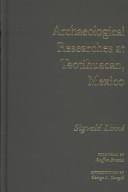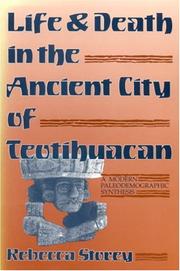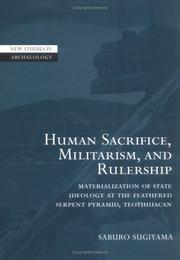| Listing 1 - 5 of 5 |
Sort by
|

ISBN: 0817383794 9780817383794 0817312935 9780817312930 0817350055 9780817350055 Year: 2003 Publisher: Tuscaloosa University of Alabama Press
Abstract | Keywords | Export | Availability | Bookmark
 Loading...
Loading...Choose an application
- Reference Manager
- EndNote
- RefWorks (Direct export to RefWorks)
The field data and archaeological analysis of the first controlled excavations of the vast ""City of the Gods"" in central Mexico. In 1932, the Ethnographical Museum of Sweden sent an archaeological expedition to Mexico under the direction of Sigvald Linné to determine the full extent of this ancient Teotihuacan occupation and to collect exhibit-quality artifacts. Of an estimated 2000-plus residential compounds at Teotihuacan, only 20 apartmentlike structures were excavated at the time. Yet Linné's work revealed residential patterns that have been confirmed later in ot

ISBN: 0817384359 058514110X 9780585141107 9780817384357 0817305599 9780817305598 Year: 1992 Publisher: Tuscaloosa, Ala. University of Alabama Press
Abstract | Keywords | Export | Availability | Bookmark
 Loading...
Loading...Choose an application
- Reference Manager
- EndNote
- RefWorks (Direct export to RefWorks)
Cities arose independently in both the Old World and in the pre-Columbian New World. Lacking written records, many of these New World cities can be studied only through archaeology, including the earliest pre-Columbian city, Teotihuacan, Mexico, one of the largest cities of its time (150 B.C. to A.D. 750). Thus, an important question is how similar New World cities are to their Old World counterparts. Before recent times, the dense populations of cities made them unhealthy places because of poor sanitation and inadequate food supplies. Storey's research shows clearly
Indians of Mexico --- Indians of North America --- Indigenous peoples --- Meso-America --- Meso-American Indians --- Mesoamerica --- Mesoamerican Indians --- Pre-Columbian Indians --- Precolumbian Indians --- Ethnology --- Anthropometry. --- Population. --- Teotihuacán Site (San Juan Teotihuacán, Mexico) --- Mexico --- Antiquities

ISBN: 9780511489563 9780521780568 0511113250 9780511113253 0511489560 128041507X 9781280415074 9786610415076 6610415072 052178056X 0511112742 9780511112744 1107129079 0511299338 0511181604 0511198434 Year: 2005 Publisher: Cambridge, UK ; New York : Cambridge University Press,
Abstract | Keywords | Export | Availability | Bookmark
 Loading...
Loading...Choose an application
- Reference Manager
- EndNote
- RefWorks (Direct export to RefWorks)
Teotihuacan was one of the earliest and more populous preColumbian cities, and the Feathered Serpent was its vital monument, erected circa 200 AD. This work explores the religious meanings and political implications of the pyramid with meticulous and thorough analyses of substantially new excavation data. Challenging the traditional view of the city as a legendary, sacred, or anonymously-governed centre, the book provides significant new insights on the Teotihuacan polity and society. It provides interpretations on the pyramid's location, architecture, sculptures, iconography, mass sacrificial graves and rich symbolic offerings, and concludes that the pyramid commemorated the accession of rulers who were inscribed to govern with military force on behalf of the gods. This archaeological examination of the monument shows it to be the physical manifestation of state ideologies such as the symbolism of human sacrifice, militarism, and individual-centred divine authority, ideologies which were later diffused among other Mesoamerican urban centres.
Indians of Mexico --- Human sacrifice --- Excavations (Archaeology) --- Human remains (Archaeology) --- Bioarchaeology --- Skeletal remains (Archaeology) --- Human skeleton --- Primate remains (Archaeology) --- Archaeological digs --- Archaeological excavations --- Digs (Archaeology) --- Excavation sites (Archaeology) --- Ruins --- Sites, Excavation (Archaeology) --- Archaeology --- Sacrifice, Human --- Sacrifice --- Indians of North America --- Indigenous peoples --- Meso-America --- Meso-American Indians --- Mesoamerica --- Mesoamerican Indians --- Pre-Columbian Indians --- Precolumbian Indians --- Ethnology --- Politics and government. --- Rites and ceremonies. --- Antiquities. --- Quetzalcoatl --- Ehecatl Quetzalcoatl --- Topiltzin Quetzalcoatl --- Ce Ácatl --- Feathered Serpent --- Plumed Serpent --- Quezacotl --- Kukulcan --- Teotihuacán Site (San Juan Teotihuacán, Mexico) --- San Juan Teotihuacán (Mexico) --- Mexico --- Antiquities --- Quetzalcoatl (Aztec deity) --- Ritual murder --- Social Sciences --- Archeology --- Quetzalcoatl (Mesoamerican deity) --- Teotihuacan Site (San Juan Teotihuacan, Mexico) --- San Juan Teotihuacan (Mexico)
Book
ISBN: 0520912284 0585134960 9780520912281 9780585134963 Year: 1992 Publisher: Berkeley, Calif. ; London : University of California Press,
Abstract | Keywords | Export | Availability | Bookmark
 Loading...
Loading...Choose an application
- Reference Manager
- EndNote
- RefWorks (Direct export to RefWorks)
In this study of warfare in ancient Mesoamerica, Hassig offers insights into 3000 years of Mesoamerican history, from roughly 1500 BC to the Spanish conquest. He examines the methods, purposes, and values of warfare as practised by the major pre-Columbian societies and shows how warfare affected the rise of the state.
Aztecs --- Indians of Mexico --- Indians of Central America --- Mayas --- Indians --- Mexico --- Regions & Countries - Americas --- History & Archaeology --- Aborigines, American --- American aborigines --- American Indians --- Amerindians --- Amerinds --- Pre-Columbian Indians --- Precolumbian Indians --- Ethnology --- Indigenous peoples --- Wars. --- Warfare --- Wars --- History --- Civilization --- Teotihuacán Site (San Juan Teotihuacán, Mexico) --- Antiquities. --- Antiquities --- Teotihuacán Site (San Juan Teotihuacán, Mexico)
Book
ISBN: 0813052785 9780813052786 9780813054285 0813054281 Year: 2017 Publisher: Gainesville
Abstract | Keywords | Export | Availability | Bookmark
 Loading...
Loading...Choose an application
- Reference Manager
- EndNote
- RefWorks (Direct export to RefWorks)
Like modern-day New York City, the ancient city of Teotihuacan in Central Mexico was built by a flood of immigrants who created a complex and diverse urban landscape. The city benefited from the knowledge, technical expertise, and experience that foreigners brought. The neighborhoods also competed with each other in displaying the finest crafts, the rarest raw materials, and the most lavish sumptuary goods. This detailed volume looks at 116 formal burials in Teopancazco, a powerful neighborhood that controlled the distribution of foreign raw materials from Teotihuacan toward Nautla in Veracruz. Applying sophisticated bioarchaeological analyses of stable and strontium isotopes, trace elements, funerary patterns, and ancient DNA, this holistic study identifies the population's age and sex profiles, paleopathologies, paleodiet, provenance, and facial approximations. What emerges is a detailed portrait of a multiethnic group working and interacting in one of the largest urban sites in the preindustrial world.
Mexico --- Teopantecuanitlan Site (Mexico) --- Tlalcozotitlan Site (Mexico) --- History --- Antiquities --- Excavations (Archaeology) --- Human remains (Archaeology) --- Migration, Internal --- Fouilles (Archéologie) --- Restes humains (Archéologie) --- Migrations intérieures --- Teotihuacán Site (San Juan Teotihuacán, Mexico) --- Mexique --- Teotihuacán (Mexique : Site archéologique) --- Population --- Indians of Mexico --- Indians of Mexico. --- Meso-America --- Meso-American Indians --- Mesoamerica --- Mesoamerican Indians --- Pre-Columbian Indians --- Precolumbian Indians --- Ethnology --- Indians of North America --- Indigenous peoples --- Industries --- To 1519
| Listing 1 - 5 of 5 |
Sort by
|

 Search
Search Feedback
Feedback About UniCat
About UniCat  Help
Help News
News